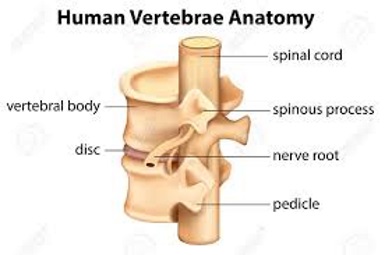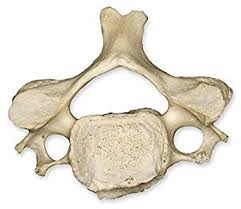human vertebrae and disc anatomy
 The twenty four vertebrae described on the previous page each have a disc between them. These discs help to cushion vertical shocks to the spine such as those that occur when jumping. This also why the spine has curves and is not "straight" as these curves help in this function.
The twenty four vertebrae described on the previous page each have a disc between them. These discs help to cushion vertical shocks to the spine such as those that occur when jumping. This also why the spine has curves and is not "straight" as these curves help in this function.
The vertebrae have a hole through them as shown here and when the vertebrae are "locked" together this provides a tunnel through which the spinal cord passes. This cord needs to be very well protected as it is, in fact, a large bunch of nerves which come from the brain and emanate outwards to all parts of the body controlling both voluntary movements and involuntary  movements which keep us alive. The hole in the vertebrae is pictured here.
movements which keep us alive. The hole in the vertebrae is pictured here.
The discs consist of a hard outer casing with a softer inner core. The discs do not have their own blood supply and cannot therefore repair themselves. Because of this, when a disc "slips" it is not usually put back in place and operations to repair it are uncommon because they can cause more harm than they fix!
In practice, when a disc slips it causes very severe pain and the part of the disk that slips is treated as a foreign body by the body's white blood cells which are immediately despatched to eat it away. As disks cannot repair themselves you lose a bit of the one that has slipped and it is never replaced. (A top spinal surgeon told me this during 2017).